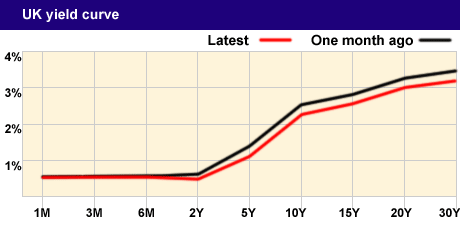Italy, Spain… is the UK next?
Keep an eye on UK government bond yields, says Bengt Saelensminde. If they keep falling, Britain could be heading for a crisis.
Back in January, I showed you The most important chart for 2011.
My chart to look out for in 2011 was the yield curve ie the interest rate on UK government bonds (gilts). "If rates get forced up, you can expect the markets to stall and reverse," I wrote at the time.
Well, against the odds the gilt yield curve has actually fallen. As a nation we can now issue 15-year debt at a trifling interest rate of 2.5%. Last year we had to pay 4%!
MoneyWeek
Subscribe to MoneyWeek today and get your first six magazine issues absolutely FREE

Sign up to Money Morning
Don't miss the latest investment and personal finances news, market analysis, plus money-saving tips with our free twice-daily newsletter
Don't miss the latest investment and personal finances news, market analysis, plus money-saving tips with our free twice-daily newsletter
And as you can see from the chart below, the yield curve keeps on falling.
The black line shows the picture a month ago, the red is as at today. So the rates on bonds with over ten years to run have dropped around a quarter of a percent. That may not sound like a lot, but it's a serious fall in just a month.

Source: FT
What's more, the markets still don't see rates rising until two years from now (that's where the red line starts rising). Well I guess Bernanke has promised that rates will be pegged for a couple of years, so now it looks like the markets are expecting the same from Sir Mervyn King and his team.
UK yield curve keeps on falling
So what does this all mean to you?
Low rates generally mean stable financial markets. And during the first half of this year, despite volatility, the markets remained broadly stable. Even house prices proved resilient with a low interest-rate tailwind.
MoneyWeek videos

The basics of bonds
Tim Bennett explains the basics of bonds - what they are and how they work.
Watch all of Tim's videos here
But during the summer, as Europe started to crack up, it's been the yield curves of the peripheral nations of Europe that we've had to watch out for. Borrowing costs for countries such as Spain and Italy are gradually shifting higher. And that's been deeply destabilising for the markets.
Yet, perversely, as yields push up in Euroland, it's helping to drive our yields down. Today I want to show you how that's happening. And why we shouldn't be lulled into a false sense of security despite our handsome looking yield curve.
EU woes keep UK rates down
Global financiers decide what rates a nation will pay on their debt. If they decide to buy your bonds, then yields stay low. As they buy bonds, prices go higher. And the higher a bond price, the lower the yield (or interest rate).
Right now the global financiers reckon the chances of Spain or Italy repaying their debts are dwindling.
The bankers and hedge funds see an opportunity to make a few quid. Here's what they do.
Let's say they want to short Italian debt (ie bet on the price falling). First they borrow some Italian bonds. They go to a friendly bank, or pension fund that's sitting on some of these dodgy bonds.
They say "Hey, what are you getting in interest on those Italian bonds of yours... 5%? Why don't you lend me the bonds instead, I'll give you 5.5% interest and you'll get your stock back in a year's time."
As soon as the financier has got hold of the stock, he sells it.
He plans to buy it back in a year's time when he assumes it'll be worth a lot less. He'll then hand the bonds back to the pension fund, having pocketed a tidy profit. Lovely jubbly.
But there's an issue. Having sold the borrowed bonds, the financier has a load of money on his hands. And seeing as he's promised to pay the pension fund (that lent him the bonds) 5.5% interest, he's going to have to put that money to work.
So he punts the cash on another bond. And for now UK Gilts don't look like a bad bet. The financier reasons that if things turn nasty for the UK, then the Bank of England will always print some sterling and buy the bonds back from him.
So right now there are a lot of buyers chasing gilts, thus pushing up the price and keeping the yields down.
And that's great news for David Cameron and George Osborne. They can tell voters that their hard works are keeping UK borrowing costs down.
But there's a danger here. Our deflated yield curve is sending out a false signal. If yields are artificially low, then we're led into bad investment decisions. Investing in property looks good when borrowing costs are low. Shares look good when a 5% dividend yield is compared to near-zero from a bank savings account.
But...
What happens when the trade unwinds?
At some point this trade has to reverse. The process of shorting European bonds is helping to gee-up short-term demand for UK gilts. But at some point these purchases will have to be sold. The speculators will need the money to buy back the bonds they shorted. Remember, they've got to give those bonds back again.
And if the bully-boy bond short-sellers have made a mint by pushing the periphery states into trouble, they'll be looking for the next target.
Now what if that includes the UK? Our debt dynamics are arguably in a much worse state than a nation like Spain's. It's just that we're able to defend ourselves because we've got an independent bank with a printable currency. While our rather unique profile is keeping speculators on-side for the moment, the situation can reverse in double-time.
As we head into 2012, keeping a close eye on that gilt yield curve has never been more important. Just because the bully-boys are sidling up to us for the moment, you shouldn't expect it to last. Playground friendships can turn on a sixpence.
We'll be keeping a close eye on that yield curve here at The Right Side. Any signs of trouble and I'll let you know. If global markets do give up on our bonds, we could have a sterling crisis on our hands just as happened in the 70s. Rates get hiked up as they have been in the European peripheral nations... and when rates go up, everything else comes down.
This article is taken from the free investment email Money Morning. Sign up to Money Morning here .
Get the latest financial news, insights and expert analysis from our award-winning MoneyWeek team, to help you understand what really matters when it comes to your finances.
Bengt graduated from Reading University in 1994 and followed up with a master's degree in business economics.
He started stock market investing at the age of 13, and this eventually led to a job in the City of London in 1995. He started on a bond desk at Cantor Fitzgerald and ended up running a desk at stockbroker's Cazenove.
Bengt left the City in 2000 to start up his own import and beauty products business which he still runs today.
-
 How cancelling unused direct debits could boost your pension by £37,000
How cancelling unused direct debits could boost your pension by £37,000A new year refresh of your spending could save you money and help boost your pension pot.
-
 NS&I cuts interest rates on 8 savings accounts
NS&I cuts interest rates on 8 savings accountsNS&I will now offer less attractive interest rates for customers wishing to lock their savings away to grow for one, two, three or five years.